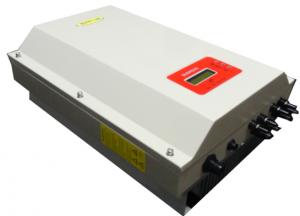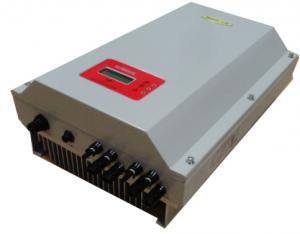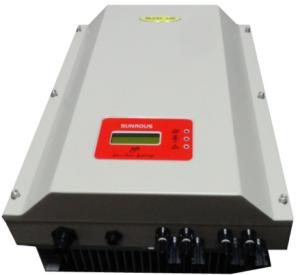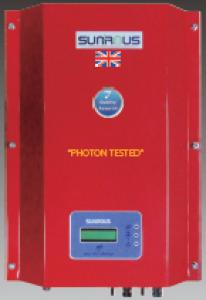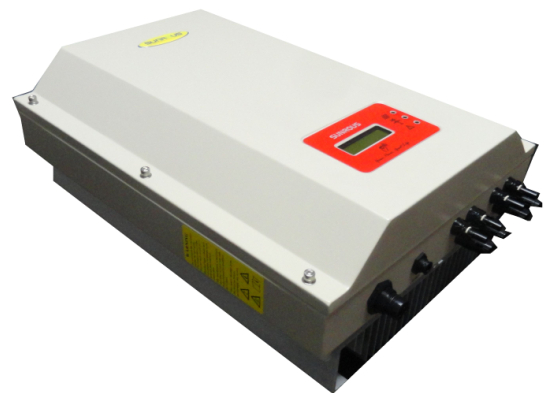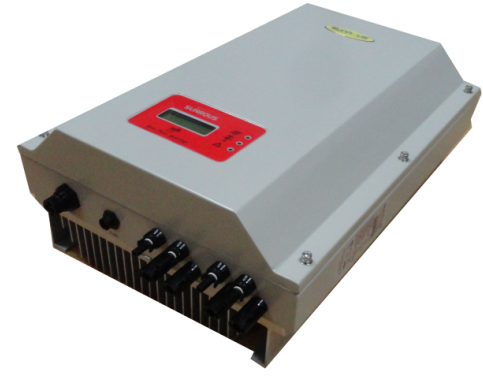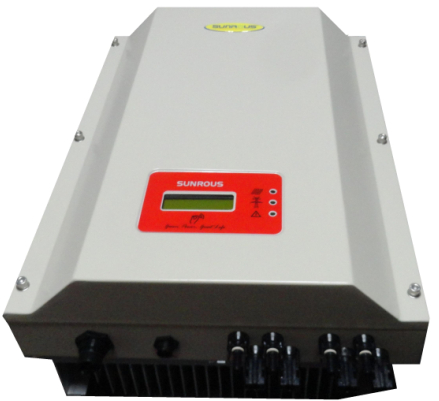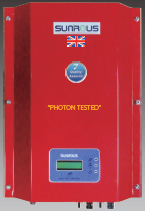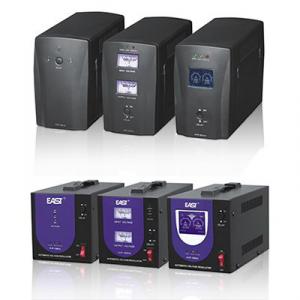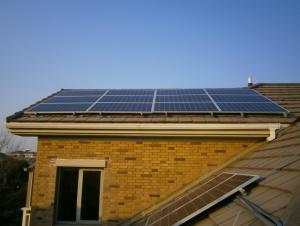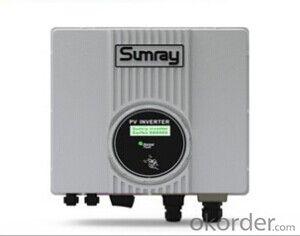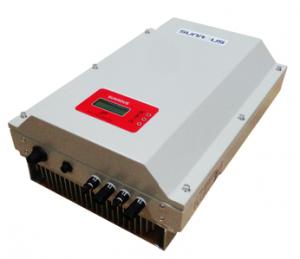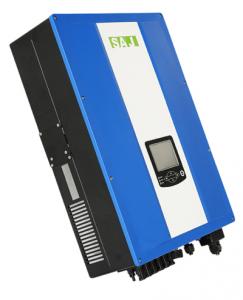16kw Grid-Tied Inverter Dual MPPT Made in China with Good Price
- Loading Port:
- Shanghai
- Payment Terms:
- TT or LC
- Min Order Qty:
- 100 mm
- Supply Capability:
- 500 mm/month
OKorder Service Pledge
OKorder Financial Service
You Might Also Like
·High frequency transformer isolation and conversion efficiency rate up to 97%.
·Dual input sections with independent MPP tracking, allows optimal energy harvesting from two sub-arrays oriented in different directions
· High speed and precise MPPT algorithm for real time power tracking and improved energy harvesting, as well as regular MPP Adaptation Efficiency of over 99.0%.
·Flat efficiency curves ensure high efficiency at all output levels ensuring consistent and stable performance across the entire input voltage and output power range
·Wide input DC MPPT range(150V~550V)/output AC voltage range (180V~264V)
·IP 65/NEMA 3R, outdoor enclosure for unrestricted use under any environmental conditions
·Any modules can be used and fit in this device whether crystalline or thin-film.
·Use in residential applications requiring PV array plug-in grounding.
·RS-485 communication interface (designed for connection to computer or data-logger)
·Easy to install and operate with reduced weight.
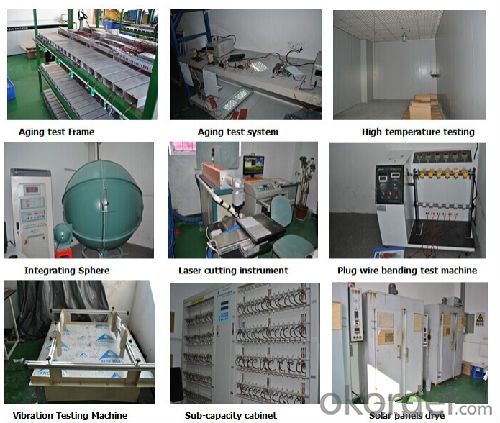
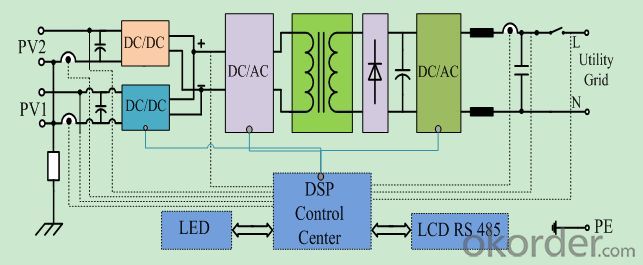
High frequency transformer isolation is the main feature of our production, which makes Installation easier due to the reduced weight and higher conversion effciency because of omitting Low frequency transformer. The wide input voltage range from 180 to 600voltage gives you extraordinary fexibility for you system design. Not need to set graphic display and RS485 communication system make the devices highly user-friendly.
This product can by multi-level parallel combination for 6kw to 20kw needed any power grade HF series technical parameter.
certificates:
American ETL certification
- GT2.0-ZX-01/HF
- GT3.0-ZX-01/HF
The European TUV certification
- GT2.0-ZX-01
- GT2.5-ZX-01
- GT3.0-ZX-01
The British G59 authentication
- GT3.8-ZX-01
- GT5.0-ZX-01
The British G83 authentication
- GT2.0-ZX-01
- GT2.5-ZX-01
- GT3.0-ZX-01
Model No. | PR-SAS300 |
Polycrystalline solar panel | 2pcs 75Wp parallel |
Max. solar panel charging voltage | 17.6V |
Max. solar panel charging current | 8.54A |
Inverter output | Pure sine wave 300W |
Inverter peak start | 900W (3s) |
Inverter output voltage/frequency | 220V/50Hz |
Inverter AC charger | 12V/10A |
Solar charge controller | 12V/15A |
Cabinet material | Steel box of zinc-plated and lacquer-coated |
Battery type | Deep cycle maintenance free |
Battery capacity | 1 x 12V 100Ah |
Operating temperature | -20oC-55oC |
Packing for solar panel | 0.06cbm/20kg |
Packing for integrated solar charge control inverter cabinet | 0.11cbm/15kg |
Packing for battery | 0.02cbm/31kg |
Whole system per set | 0.19cbm/66kg |
Optional monitoring software | CD-ROM for computer and SNMP card for internet |
Q1 : What is you advantages
A1:
a).We are professional ups manufacturer for more than ten years and we have these staffs with rich
production and R&D
b) Excellent workers and skilled engineers
c).Our aims are to provide every customer high quality, reasonable price and excellent
service.
d)we can guarantee to send the goods on time. And also accept any transportation ways that
you require
Q2 : How do you control the production quality
A2:
a) For materials, we have IQC departments and the IQC testing follow MIL-STD-105E standard
b) in production have 4 times function testing
c) all of our products with 100% burn-in testing
d) 100% QC testing before delivery
- Q: How does a solar inverter handle anti-islanding protection?
- A solar inverter handles anti-islanding protection by continuously monitoring the grid's voltage and frequency. If the grid's voltage or frequency deviates from the predetermined range, indicating a potential islanding condition, the inverter quickly disconnects from the grid to prevent energy flow. This ensures the safety of utility workers and prevents damage to the electrical grid.
- Q: What is the role of a solar inverter in a solar-powered ventilation system?
- The role of a solar inverter in a solar-powered ventilation system is to convert the direct current (DC) electricity generated by the solar panels into alternating current (AC) electricity, which is the type of electricity used in most household appliances. This conversion allows the ventilation system to effectively utilize the solar energy and power the fans, motors, or other components of the system.
- Q: What happens to excess solar energy generated by the inverter?
- Excess solar energy generated by the inverter can either be stored in batteries for later use or fed back into the grid, depending on the setup.
- Q: Can a solar inverter be used with both AC and DC power sources?
- No, a solar inverter is designed to convert DC power from solar panels into AC power for use in standard electrical systems. It cannot be used with both AC and DC power sources simultaneously.
- Q: Can a solar inverter be used with different types of grid support functions?
- Yes, a solar inverter can be used with different types of grid support functions. Solar inverters are designed to convert the direct current (DC) produced by solar panels into alternating current (AC) that can be fed into the electrical grid. They can be equipped with various grid support functions like reactive power control, voltage regulation, and frequency control. These functions enable solar inverters to adapt to different grid requirements and contribute to grid stability and reliability.
- Q: What is the importance of voltage and frequency control in a solar inverter?
- The importance of voltage and frequency control in a solar inverter is crucial for maintaining the stability and reliability of the power output. By regulating the voltage and frequency levels, the inverter ensures that the electricity generated from the solar panels is in sync with the grid requirements. This control is necessary to prevent damage to electrical appliances and equipment, maintain grid stability, and enable seamless integration of solar energy into the existing power system.
- Q: Can a solar inverter be used with a remote control system?
- Yes, a solar inverter can be used with a remote control system. Many modern solar inverters come equipped with built-in communication interfaces that allow for remote monitoring, control, and adjustment of the inverter's settings. This can be done through a dedicated software or mobile application, allowing users to conveniently manage their solar energy system from a remote location.
- Q: What is the role of a fault detection feature in a solar inverter?
- The role of a fault detection feature in a solar inverter is to monitor and identify any malfunctions or abnormalities within the system. It is responsible for detecting faults such as overvoltage, under-voltage, over-temperature, short circuits, ground faults, or any other potential issues that may arise. This feature helps ensure the safe and efficient operation of the solar inverter by promptly alerting the user or system operator about the fault, allowing for quick troubleshooting and maintenance.
- Q: What is the difference between a single-phase and three-phase solar inverter?
- A single-phase solar inverter is designed to convert the DC power generated by solar panels into AC power for use in single-phase residential or small-scale commercial applications. It typically has one input and one output, and is suitable for systems with a single-phase electrical supply. On the other hand, a three-phase solar inverter is designed to convert DC power into AC power for use in three-phase electrical systems, which are commonly found in larger commercial or industrial settings. It has three inputs and three outputs, allowing for a more balanced distribution of power across the phases. In summary, the main difference between a single-phase and three-phase solar inverter lies in their compatibility with different electrical systems. Single-phase inverters are suitable for smaller-scale applications, while three-phase inverters are better suited for larger-scale installations with three-phase power supply.
- Q: Can a solar inverter be used with a solar-powered data center?
- Yes, a solar inverter can be used with a solar-powered data center. A solar inverter is an essential component that converts the direct current (DC) produced by solar panels into alternating current (AC) that can be used to power electrical equipment, including data centers. By integrating a solar inverter into the solar power system of a data center, the generated solar energy can be efficiently used to run the center's operations, reducing reliance on grid electricity and promoting sustainability.
Send your message to us
16kw Grid-Tied Inverter Dual MPPT Made in China with Good Price
- Loading Port:
- Shanghai
- Payment Terms:
- TT or LC
- Min Order Qty:
- 100 mm
- Supply Capability:
- 500 mm/month
OKorder Service Pledge
OKorder Financial Service
Similar products
Hot products
Hot Searches
Related keywords
